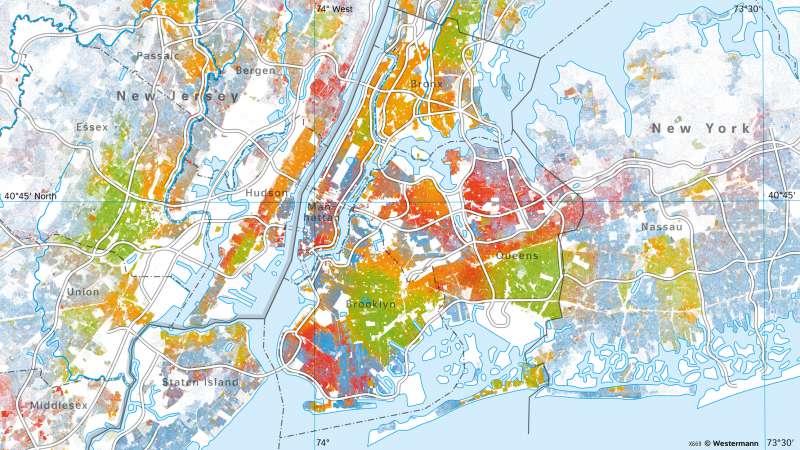New York - Segregation of ethnic groups
East Coast cities
978-3-14-100890-6 | Page 191 | Ill. 4

Overview
With around 8.5 million inhabitants, the city of New York has a larger population than Switzerland. Yet the size of city area is only 1214 square kilometres. Since about one third of this area is water, only 786 square kilometres of land remain (for comparison: Berlin has 892 square kilometres). The average population density is therefore about 10,800 inhabitants per square kilometre, almost three times as high as in the German capital.
Population distribution
New York is divided into five boroughs. The largest in terms of population is Brooklyn with 2.6 million inhabitants on 251 square kilometres (including 68 km² of water), followed by Queens with 2.4 million inhabitants on 462 square kilometres (including 179 km² of water), Manhattan with 1, 7 million inhabitants on 87 square kilometres (of which 28 km² water), Bronx with 1.5 million inhabitants on 149 square kilometres (of which 40 km² water) and finally Staten Island with just under 500,000 inhabitants on 265 square kilometres (of which 114 km² water) (as of 2017). Manhattan has by far the highest population density of 28,000 inhabitants per square kilometre, followed by Brooklyn (14 500 inhabitants per square kilometre) and Bronx (13 500 inhabitants per square kilometre). Bronx is on the mainland, all other boroughs are either independent islands like Manhattan and Staten Island or are on Long Island like Brooklyn and Queens; they are connected by a multitude of bridges, tunnels, and ferries.
Population groups
New York has been shaped by immigrants and their cultural diversity like no other city. In the process, spatially separated centres of concentration of the various ethnic groups and immigrant groups have formed within the city area, even if they are now partially disentangled again. The population of African origin lives mainly in the north of the Bronx, in Brooklyn and in Queens, while Hispanics are concentrated in the Bronx, Queens and the outer boroughs west of the Hudson. The Asian population is concentrated in Chinatown (part of Manhattan), Queens, southwest Brooklyn, and the northern suburbs.
Population groups
New York has been shaped by immigrants and their cultural diversity like no other city. In the process, spatially separated centres of concentration of the various ethnic groups and immigrant groups have formed within the city area, even if they are now partially disentangled again. The population of African origin lives mainly in the north of the Bronx, in Brooklyn and in Queens, while Hispanics are concentrated in the Bronx, Queens and the outer boroughs west of the Hudson. The Asian population is concentrated in Chinatown (part of Manhattan), Queens, southwest Brooklyn, and the northern suburbs.




